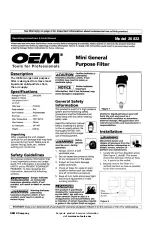
OPERATION
The sprinkler assembly contains a
small fusible solder element. When ex-
posed to sufficient heat from a fire, the
solder melts and enables the internal
components of the sprinkler to fall
away. At this point the sprinkler acti-
vates with the deflector dropping into
its operated position (Reference Fig-
ure 1C), permitting water to flow.
INSTALLATION
The Model TFP1 must be installed in
accordance with the following instruc-
tions:
NOTES
The Protective Cap is to remain
on the sprinkler during installa-
tion and until the ceiling instal-
lation is complete. The Protective
Cap must be removed to place the
sprinkler in service.
A leak tight 1/2 inch NPT sprin-
kler joint should be obtained with
a torque of 7 to 14 ft.lbs. (9,5 to
19,0 Nm). A maximum of 21 ft.lbs.
(28,5 Nm) of torque is to be used to
install sprinklers. Higher levels
of torque may distort the sprin-
kler inlet with consequent leak-
age or impairment of the sprin-
kler.
Do not attempt to compensate for
insufficient adjustment in an Es-
cutcheon Plate by under- or over-
tightening the Sprinkler. Read-
just the position of the sprinkler
fitting to suit.
Step 1.
The Sprinkler must be installed
only in the pendent position and with
the Sprinkler waterway centerline per-
pendicular to the mounting surface.
Step 2.
Install the sprinkler fitting so
that the distance from the face of the
fitting to the mounting surface will be
nominally 29/32 inches (23,0 mm) as
shown in Figure 1A.
Step 3.
With pipe thread sealant ap-
plied to the pipe threads, hand tighten
the Sprinkler into the sprinkler fitting.
Step 4.
Wrench tighten the Sprinkler
using only the Sprinkler Socket or
Wrench & Socket Combination (Ref.
Figure 4). The wrench recess of the
Socket is to be applied to the sprinkler
wrenching area (Ref. Figure 1A).
Step 5.
Use the “ceiling level tolerance
limit” indicator on the Protective Cap to
check for proper installation height.
Relocate the sprinkler fitting as neces-
sary. If desired the Protective Cap may
also be used to locate the center of the
clearance hole by gently pushing the
ceiling material against the center
point of the Cap.
Step 6.
After the ceiling has been com-
pleted with the 2 inch (50 mm) diame-
ter clearance hole, use the Protective
Cap Removal Tool (Ref. Figure 5) to
remove the Protective Cap and then
push on the Escutcheon until its flange
just comes in contact with the ceiling.
Do not continue to push on the Es-
cutcheon such that it lifts a ceiling
panel out of its normal position. If the
Escutcheon cannot be engaged with
the Sprinkler, or the the Escutcheon
cannot be engaged sufficiently to con-
tact the ceiling, relocate the sprinkler
fitting as necessary.
CARE AND MAINTENANCE
The Model TFP1 must be maintained
and serviced in accordance with the
following instructions:
NOTES
It is the responsibility of the in-
stalling contractor to provide a
copy of this document to the
owner or his representative, and
in turn, it is the obligation of the
owner to provide a copy of this
document to a succeeding owner.
Wet pipe sprinkler systems must
be maintained at a minimum tem-
perature of 40°F/4°C to prevent
freezing and bursting of the pipe
and/or sprinklers.
Automatic sprinklers are not to be
tested with a heat source. Opera-
tion of the heat responsive ele-
ment can result.
Absence of an Escutcheon Plate
may delay the time to sprinkler
operation in a fire situation.
Before closing a fire protection
system main control valve for
maintenance work on the fire pro-
tection system which it controls,
permission to shut down the af-
fected fire protection system must
be obtained from the proper
authorities and all personnel who
may be affected by this action
must be notified.
Do NOT enclose sprinklers within
drapes, curtains, or valances.
Do NOT hang anything from the
sprinklers.
Do NOT cleanse the sprinklers
with soap and water, detergents,
ammonia, cleaning fluids, or
other chemicals. Remove dust,
lint, cobwebs, cocoons, insects,
and larvae by gently brushing
with a feather duster or gently
vacuuming with a soft bristle (i.e.,
dusting) brush attachment.
Exercise suitable safety precau-
tions in the use and storage of
highly flammable materials. The
rapid rate of fire development
and spread of which can be
FIGURE 4
TFP1 SPRINKLER SOCKET
TFP1 WRENCH & SOCKET COMBINATION
DRIVE
3/8" SOCKET
ACCEPTS
WRENCH
RECESS
WRENCH
COMBINATION
WRENCH & SOCKET
#4948
#4947
SOCKET
FIGURE 5
TFP1 PROTECTIVE CAP
REMOVAL TOOL
-5-
OBSOLETE
Close


























